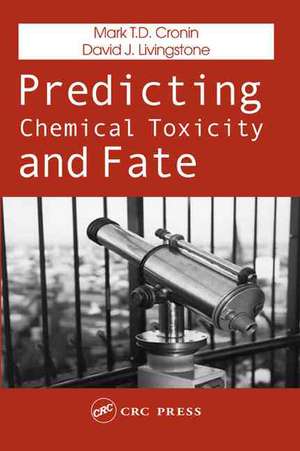Predicting Chemical Toxicity and Fate
Editat de Mark T. D. Croninen Limba Engleză Hardback – 10 mai 2004
Predicting Chemical Toxicity and Fate provides a comprehensive explanation of the state-of-the-art methods that are available to predict the effects of chemicals on humans and the environment. It describes the use of predictive methods to estimate the physiochemical properties, biological activities, and fate of chemicals. The methods described may be used to predict the properties of drugs before their development, and to predict the environmental effects of chemicals. These methods also reduce the cost of product development and the need for animal testing.
This book fills an obvious need by providing a comprehensive explanation of these prediction methods. It is a practical book that illustrates the use of these techniques in real life scenarios. This book will demystify QSARs for those students unsure of them, and professionals in environmental toxicology and chemistry will find this a useful reference in their everyday working lives.
Preț: 986.91 lei
Preț vechi: 1366.55 lei
-28% Nou
Puncte Express: 1480
Preț estimativ în valută:
188.84€ • 205.77$ • 159.13£
188.84€ • 205.77$ • 159.13£
Comandă specială
Livrare economică 02-16 aprilie
Doresc să fiu notificat când acest titlu va fi disponibil:
Se trimite...
Preluare comenzi: 021 569.72.76
Specificații
ISBN-13: 9780415271806
ISBN-10: 0415271800
Pagini: 472
Ilustrații: 80 b/w images, 76 tables, 3 halftones and 220 equations
Dimensiuni: 178 x 254 x 31 mm
Greutate: 0.45 kg
Ediția:New.
Editura: CRC Press
Colecția CRC Press
Locul publicării:Boca Raton, FL, United States
ISBN-10: 0415271800
Pagini: 472
Ilustrații: 80 b/w images, 76 tables, 3 halftones and 220 equations
Dimensiuni: 178 x 254 x 31 mm
Greutate: 0.45 kg
Ediția:New.
Editura: CRC Press
Colecția CRC Press
Locul publicării:Boca Raton, FL, United States
Public țintă
ProfessionalCuprins
Introduction. Methodology. QSARs for Human Health Endpoints. QSARs for Environmental Toxicity and Fate Part. Application.
Recenzii
"This book provides a comprehensive explanation of the state-of-the-art methods that are available to predict the effects of chemicals on humans and the environment. … The book fills an obvious need by providing a comprehensive explanation of these prediction methods. It is a practical book that illustrates the use of these techniques in real life scenarios. It will demystify QSARs for those students unsure of the them, and professionals in environmental toxicology and chemistry will find this a useful reference in their everyday working lives."
- International Pest Control, Vol. 47, No. 2, March/April 2005
"The authors and editors have done a fine job in presenting a well balanced view of the early development, current status and future uses of predictive models/(Q)SARs for use in both human health assessments and environmental assessments. … Anyone interested in predictive modelling of mammalian toxicity and environmental effects should consider this book … ."
- BTS Newsletter, Winter 2004, Issue 25
"This choice [of contributors] provides a refreshing outlook on certain topics… we learn what research has been done, what needs most to be done, and why successes have been limited. This is exactly the sort of state-of-the-art description an overview volume should provide."
- Journal of Medicinal Chemistry, Vol. 48, No. 13, 2005
- International Pest Control, Vol. 47, No. 2, March/April 2005
"The authors and editors have done a fine job in presenting a well balanced view of the early development, current status and future uses of predictive models/(Q)SARs for use in both human health assessments and environmental assessments. … Anyone interested in predictive modelling of mammalian toxicity and environmental effects should consider this book … ."
- BTS Newsletter, Winter 2004, Issue 25
"This choice [of contributors] provides a refreshing outlook on certain topics… we learn what research has been done, what needs most to be done, and why successes have been limited. This is exactly the sort of state-of-the-art description an overview volume should provide."
- Journal of Medicinal Chemistry, Vol. 48, No. 13, 2005
Descriere
Quantitative Structure-Activity Relationships (QSARs) are increasingly used to predict the toxicity and fate of chemicals both to man and in the environment. While these methods are used in a variety of areas (academic, industrial, regulatory), there is little coherent information available on their use. This book provides a comprehensive explanation of the state of the art prediction methods that are available. This unique, practical book illustrates the use of these techniques in real life scenarios. It will demystify QSARs for students and professionals in environmental toxicology and chemistry will provide a useful reference for their everyday working lives.
